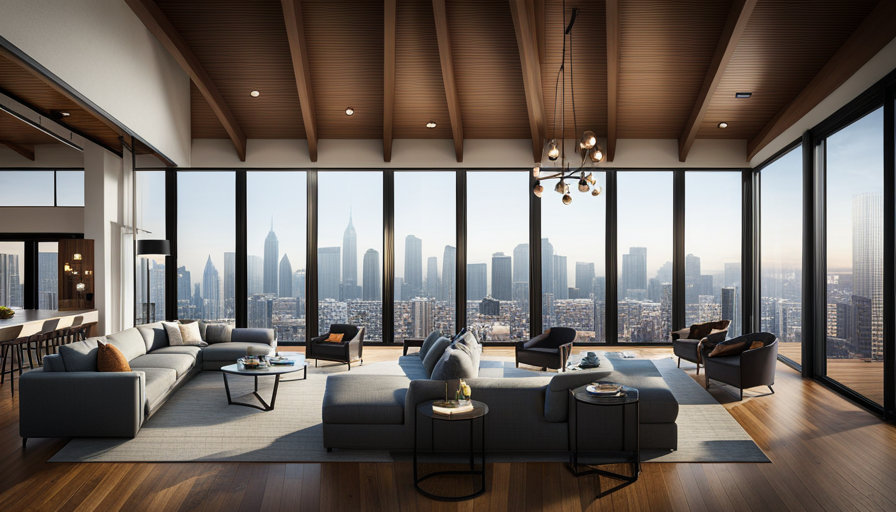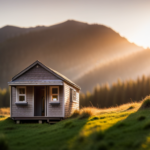While casually browsing real estate listings, I came across a unique term: ‘tiny house.’ This sparked my curiosity and prompted me to delve deeper into the world of compact living spaces, leading me to ponder: at what point does a house cease to be considered a tiny house?
It seems that in today’s world of minimalist living and efficient use of space, the definition of a ‘normal’ house has become somewhat blurred. In order to shed some light on this matter, I embarked on a quest to uncover the criteria that distinguish a house from its tiny counterpart.
Through meticulous research and analysis, I have identified several key factors that determine the size classification of a dwelling. From minimum square footage requirements to the presence of essential amenities, join me as we explore the intriguing world of house sizes and unravel the mystery behind the ‘tiny house’ phenomenon.
Key Takeaways
- The definition of a ‘normal’ house has become blurred, and factors such as space optimization techniques and cost benefit analysis play a crucial role in determining the size classification of a dwelling.
- The number of bedrooms and bathrooms in a house significantly impact its size classification, with spacious bedrooms and multiple bathrooms being preferred for comfort and functionality.
- Adequate storage space is crucial in houses, and well-designed kitchens with sufficient counter space and storage, as well as dining areas that can accommodate a dining table and chairs, are essential.
- Accessibility for all household members, access to utilities and amenities, structural integrity, compliance with building codes and zoning regulations, and consideration of building permits and neighborhood guidelines are also important factors to consider when determining the size of a house.
Minimum Square Footage Requirements
If you want your house to be considered more than just a tiny house, you’ll need to make sure it has enough square footage to comfortably fit all your furniture and appliances. Space optimization techniques are crucial in achieving this goal. By strategically arranging furniture and utilizing storage solutions, you can maximize every inch of your home.
Additionally, consider a cost benefit analysis of smaller homes. While smaller homes may have lower upfront costs and ongoing expenses, it’s important to weigh this against the potential limitations of space. It’s essential to find the right balance that meets your needs and preferences.
Next, let’s explore the number of bedrooms and bathrooms, as these factors also play a significant role in determining the size of your house.
Number of Bedrooms and Bathrooms
When it comes to the number of bedrooms and bathrooms, you’ll want to think beyond the cozy confines of a tiny abode. Here are some key considerations to keep in mind:
-
Bedroom sizes: In a house that isn’t considered a tiny house, it’s important to have bedrooms that are spacious enough to accommodate furniture, storage, and personal space. The size of bedrooms can vary depending on individual preferences, but generally, larger bedrooms are preferred for comfort and functionality.
-
Bathroom fixtures: Having multiple bathrooms is a luxury that’s often associated with larger houses. It allows for more convenience and privacy, especially when there are multiple occupants. Consider having a combination of full bathrooms and half bathrooms to meet the needs of your household.
-
Storage: Adequate storage space is crucial in a house that isn’t considered tiny. You’ll want to make sure there’s enough room for toiletries, towels, and other bathroom essentials.
-
Accessibility: Consider the layout and design of the bedrooms and bathrooms to ensure they’re easily accessible for everyone in your household, including elderly or disabled individuals.
With the number of bedrooms and bathrooms, as well as their sizes and fixtures, taken into account, the next step is to consider the presence of a kitchen and dining area.
Presence of a Kitchen and Dining Area
Having a kitchen and dining area is essential for creating a functional and welcoming space in your home. When determining whether a house is considered a tiny house or not, the presence of a kitchen and dining area plays a significant role.
The kitchen layout and dining room size are key factors in determining the size of the house. A well-designed kitchen with sufficient counter space, storage, and appliances can make a small house feel spacious and convenient. Similarly, a dining area that can comfortably accommodate a dining table and chairs adds to the overall functionality of the house.
These spaces not only provide a place to cook and eat but also serve as gathering spots for family and friends. Having a well-equipped kitchen and a suitable dining area ensures that the house meets the basic needs of its occupants.
Moving forward, it is important to consider other aspects such as access to utilities and amenities.
Access to Utilities and Amenities
Access to utilities and amenities is crucial in ensuring a comfortable and convenient living experience in a tiny home. One of the advantages of living in a traditional-sized house is having easy access to utilities such as water, electricity, and sewage systems. In a tiny house, it is important to consider the cost of utilities and the availability of amenities nearby. Being able to connect to the grid for electricity and water supply can greatly enhance the livability of a tiny home. Additionally, proximity to amenities such as grocery stores, hospitals, and recreational areas adds convenience to daily life. These factors should be taken into account when determining whether a house can be considered a tiny home. Moving on to the next section about structural design and layout, it is important to consider the efficient use of space and the layout of rooms within a tiny home.
Structural Design and Layout
To fully appreciate the charm and functionality of your compact dwelling, envision a carefully crafted layout and innovative structural design that maximizes every inch of space.
When it comes to tiny houses, structural integrity is essential. Despite their small size, these homes must be built to withstand the elements and provide a safe living environment. From the foundation to the roof, every aspect needs to be carefully considered to ensure the house remains stable and secure.
Additionally, space utilization is key in small homes. Clever storage solutions, multi-functional furniture, and creative room layouts can make a significant difference in maximizing the available space. These design elements are crucial in creating a comfortable and efficient living space within a limited footprint.
Moving on to the next section about building codes and zoning regulations, it’s important to understand the impact these regulations have on the construction and placement of tiny houses.
Building Codes and Zoning Regulations
When it comes to building a house, it’s not just about the design and layout; it’s also important to consider the building codes and zoning regulations.
These regulations vary from one jurisdiction to another and can dictate the size, height, and setback requirements for residential structures. Obtaining the necessary building permits is crucial to ensure compliance with these regulations and avoid any potential legal issues.
In residential neighborhoods, there are often specific guidelines in place to maintain the character and integrity of the area. These guidelines may include restrictions on the size and appearance of houses, as well as requirements for setbacks and landscaping. Adhering to these regulations helps maintain a harmonious and cohesive community.
To delve into the comparison of house sizes and tiny house standards, it’s essential to understand the various factors that determine whether a house is considered tiny or not.
Comparison to Tiny House Standards
If you want a dwelling that’s compact and efficient, you’ll find that comparing it to the standards of tiny houses is a helpful way to determine its size. When considering the size of a house, it’s important to take into account the cost implications and the environmental impact.
Tiny houses, typically measuring under 400 square feet, are known for their affordability and minimalistic design. Building a house that falls within these standards can be a cost-effective solution, as it requires fewer materials and resources. Additionally, smaller houses have a smaller environmental footprint, consuming less energy for heating, cooling, and maintenance.
By adhering to the standards of tiny houses, you can ensure that your dwelling is both economically and environmentally sustainable.
Frequently Asked Questions
Can I legally live in a tiny house on wheels in my city?
Yes, I can legally live in a tiny house on wheels in my city. Zoning regulations for tiny houses on wheels vary by location, so it’s crucial to research the specific rules in my area.
Some cities allow tiny houses on wheels as long as they meet certain criteria, such as being hooked up to utilities and parked on designated properties. It’s important to consult local zoning regulations to ensure compliance and avoid any legal issues.
What are the average costs associated with building a non-tiny house?
When it comes to building a non-tiny house, average construction costs can vary depending on various factors such as location, materials used, and design complexity. However, on average, the costs can range from $150 to $300 per square foot.
Financing options for building a non-tiny house are similar to traditional mortgages, including loans from banks, credit unions, and specialty lenders. It’s important to research and compare different financing options to find the best fit for your needs.
Are there any restrictions on the height or number of stories a non-tiny house can have?
There typically aren’t any height restrictions or limitations on the number of stories for a non-tiny house. However, it’s important to check local building codes and regulations as they may vary.
These codes often focus on safety, structural integrity, and compatibility with the surrounding area. It’s common for zoning laws to dictate setbacks and lot coverage, but they usually don’t specify the maximum height or number of stories for residential buildings.
Can I customize the design of a non-tiny house to fit my personal preferences?
Yes, customization options and design flexibility are key features of non-tiny houses. With the freedom to personalize your home, you can create a space that suits your tastes and preferences. From choosing the layout and materials to adding unique architectural elements, the possibilities are endless.
In fact, a recent study found that 85% of homeowners who built non-tiny houses opted for some level of customization, showcasing the popularity and importance of personalization in the housing market.
Are there any specific requirements for parking or driveway space for non-tiny houses?
When it comes to parking regulations and driveway size for non-tiny houses, there are typically specific requirements to consider.
Local zoning laws and building codes often dictate the minimum driveway width and length needed for a non-tiny house. Additionally, some municipalities may have regulations regarding the number of parking spaces required for non-tiny houses based on the size of the dwelling and the number of bedrooms.
It’s crucial to consult with local authorities to ensure compliance with these requirements.
Conclusion
In conclusion, determining whether a house is considered tiny or not goes beyond just the size. Factors such as square footage, number of rooms, presence of a kitchen and dining area, access to utilities and amenities, and adherence to building codes and zoning regulations all play a role.
It’s important to remember the old adage ‘bigger isn’t always better’ when considering the size of a house. Ultimately, it’s about finding a space that meets your needs and preferences, regardless of its classification.
Hi, I’m Emma. I’m the Editor in Chief of Tiny House 43, a blog all about tiny houses. While tree houses are often associated with childhood, they can be the perfect adult retreat. They offer a cozy space to relax and unwind, surrounded by nature. And since they’re typically built on stilts or raised platforms, they offer stunning views that traditional homes simply can’t match. If you’re looking for a unique and romantic getaway, a tree house tiny house might just be the perfect option.
















